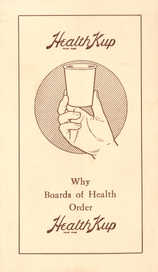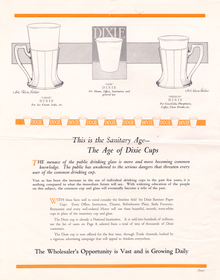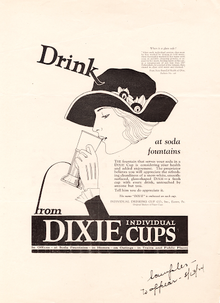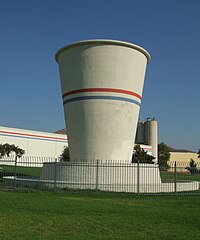What are paper cups made of?
A paper cup is a disposable cup made out of paper and often lined or coated with plastic or wax to prevent liquid from leaking out or soaking through the paper.[1][2][3] It may be made of recycled paper[4] and is widely used around the world.
History[edit]
Paper cups have been documented in imperial China, where paper was invented by 2nd century BC.[5] Paper cups were known as chih pei and were used for the serving of tea.[6] They were constructed in different sizes and colors, and were adorned with decorative designs. Textual evidence of paper cups appears in a description of the possessions of the Yu family, from the city of Hangzhou.[6]
The modern paper cup was developed in the 20th century. In the early 20th century, it was common to have shared glasses or dippers at water sources such as school faucets or water barrels in trains. This shared use caused public health concerns. One notable investigation into their use was the study by Alvin Davison, biology professor at Lafayette College, published with the sensational title “Death in School Drinking Cups” in Technical World Magazine in August 1908, based on research carried out in Easton, Pennsylvania‘s public schools. The article was reprinted and distributed by the Massachusetts State Board of Health in November 1909.[7]
Based on these concerns, and as paper goods (especially after the 1908 invention of the Dixie Cup) became cheaply and cleanly available, local bans were passed on the shared-use cup. One of the first railway companies to use disposable paper cups was the Lackawanna Railroad, which began using them in 1909. By 1917, the public glass had disappeared from railway carriages, replaced by paper cups even in jurisdictions where public glasses had yet to be banned.[8]
Paper cups are also employed in hospitals for health reasons. In 1942 the Massachusetts State College found in one study that the cost of using washable glasses, re-used after being sanitized, was 1.6 times the cost of using single-service paper cups.[9] These studies, as well as the reduction in the risk of cross-infection, encouraged the use of paper cups in hospitals.
Germ Theory and Paper Cups[edit]
Initial interest in and movement toward the banning of public drinking cups can be traced back to the Plague of 1564 when individual communion cups were banned in European churches out of suspicion that the common cup let to the spread of illness.[2] However, scientific query into the safety of communal drinking cups was first recorded in 1901 when A. Metzger and N. C. Müller surveyed 112 physicians throughout the United States who shared health concerns related to the common drinking cup, finding that suspicions of danger were justified based on input from many of these physicians. Scientists O. Ruepke and H. Huss of New York later conducted a study of guinea pigs wherein they proved tuberculosis could be transmitted from “one mouth to another by means of a drinking glass.”[2]
Death in School Drinking Cups[edit]
Another significant discovery came in 1907, when a study done by Lafayette College professor Alvin Davison concluded that the common drinking cups which were used at most water fountains were a repository for disease-causing germs and bacteria. By analyzing over 2000 students in the Easton Public School system he saw that “the germs of diphtheria and grippe frequently remain from one to three months in the mouths of the patients after they have recovered.”[3] Davison took deposits that were present on public drinking vessels in the schools and fed them to guinea pigs. He examined fragments of these cups and estimated that they contained over 20,000 human cells and that each cell had as close to 150 germs clinging to it. After giving a sample of the cells and bacteria on the drinking cups to two guinea pigs, one died within two days and the second died a few weeks later. Davison found traces of pneumonia and tuberculosis germs in both corpses. Davison concluded that the common drinking cup was a harbor for dangerous germs that caused diseases and recommended that they should no longer be used in public spaces.
Public Response[edit]
Following this mounting definitive evidence, states began to pass bans on public drinking cups. As of February 1911, 7 states had abolished the common drinking cup and many more would follow. Moreover, “more than 40 railroads throughout the country [had] substituted the individual paper cups for the old time rusty cup familiar to everyone.”[4] Beyond bans in public places, institutions including public schools and railroad companies began to react to the pressure to curb the usage of public cups. Again as of 1911, “The public schools throughout our country are rapidly awakening to the problem. In a very large percent of our cities some form of bubbling fountain or the individual drinking cup is now used.”[4]
The publication of this information in 1911 in a major journal speaks to the wave of criticism permeating the mainstream that started the movement against public drinking cups. It was precisely this wave that the Dixie Company (as well as rival paper cup companies) positioned itself to ride and strengthen as sales began to take off.
Early Advertisements[edit]
Initial branding was centralized around the health benefits of the single use cup. Marketing techniques took advantage of the trends against public drinking cups both through distribution of leaflets warning of health concerns as well as through slogans such as “don’t be last” to encourage people to view individual use drinking cups as “the future.”
Marketing toward companies that might use Dixie Cup vending machines was also developed, and the patents of the product were emphasized. “The product is not an expense” and people will gladly pay a penny for an individual use drinking cup.[1] The product began to capture the attention of the public and marketing became the company’s main objective.
Early advertisement for Dixie Cups when they were still known as Health Kups[7]
“This is the Sanitary Age” advertisement for Dixie Cups[7]
The tone of many of the advertisements created by the Dixie Cup Company took the form of embracing modern ideals and marketing towards people who wanted to improve their lives and jump on board a new trend for fear of being left behind. “This is the sanitary age — the age of dixie cups,”[11] was used for several years with success.
A subsequent pivot towards soda fountains was made in both product line and advertising, but the central idea of individual use as more sanitary than reusable glasses persisted. An emphasis on the theme of cups being “touched only by you” was seen as an act to make the cups seem individualized.
Manufacture[edit]
The world’s largest “paper” cup in front of what was once the Lily-Tulip manufacturing company, later Sweetheart Cup Company.[12] Made of poured concrete, the cup stands about 68.1 feet (20.8 m) tall.
The base paper for paper cups is called “cup board”, and is made on special multi-ply paper machines. It has a barrier coating for waterproofing. The paper needs high stiffness and strong wet sizing. The cup board grade has a special design for the cup manufacturing processes. The mouth roll forming process requires good elongation properties of the board and the plastic coating. A well formed mouth roll provides stiffness and handling properties in the cup. The basis weights of the cup boards are 170–350 g/m2.[13]
To meet hygiene requirements, paper cups are generally manufactured from virgin (non-recycled) materials.[citation needed] The one exception to this is when the paper cup features an extra insulating layer for heat retention, which never comes into contact with the beverage, such as a corrugated layer wrapped around a single-wall cup.
Waterproofing[edit]
Originally, paper cups for hot drinks were glued together and made waterproof by dropping a small amount of clay in the bottom of the cup, and then spinning at high speed so that clay would travel up the walls of the cup, making the paper water-resistant.[citation needed] However, this resulted in drinks smelling and tasting of cardboard.
Cups for cold drinks could not be treated in the same way, as condensation forms on the outside, then soaks into the board, making the cup unstable. To remedy this, cup manufacturers developed the technique of spraying both the inside and outside of the cup with wax. Clay- and wax-coated cups disappeared with the invention of polyethylene (PE)-coated cups; this process covers the surface of the board with a very thin layer of PE, waterproofing the board and welding the seams together.
In 2017, the Finnish board manufacturer Kotkamills launched a new kind of cup (food service) board which uses no wax or plastic for waterproofing, and thus can be recycled as part of the normal paper and board waste stream, biodegraded, or even composted in small quantities.[14]
in 2017, the Newport Beach CA company Smart Planet Technologies, launched “reCUP” for the UK market, a recyclable paper cup using a polyethylene and mineral-blended coating, that is engineered to be recycled through traditional paper recycling systems.[15]
Printing on paper cups[edit]
|
This section does not citeany sources. (September 2017) (Learn how and when to remove this template message)
|
Originally paper cups were printed using rubber blocks mounted on cylinders, with a different cylinder for each colour. Registration across different colours was very difficult, but later flexography plates became available and with the use of mounting systems it became easier to register across the colours, allowing for more complex designs. Printing flexographic has become ideal for long runs and manufacturers generally use this method when producing over a million cups. Machines such as Comexi are used for this, which have been adapted to take the extra large reels that are required by paper cup manufacturers. Ink technology has also changed and where solvent-based inks were being used, water-based inks are instead being utilised. One of the side effects of solvent-based inks is that hot drink cups in particular can smell of solvent, whereas water-based inks have eliminated this problem. Other methods of printing have been used for short runs such as offset printing, which can vary from anything from 10,000 to 100,000 cups. Offset printing inks have also been developed and although in the past these were solvent based, the latest soya-based inks have reduced the danger of cups smelling. The latest development is Direct-printing, which allows printing on very small quantities, typically from 1,000 cups, and is used by companies including Brendos ltd offering small quantities in short lead times. Rotogravure can also be used, but this is extremely expensive and is normally only utilised for items requiring extremely high quality printing like ice cream containers.
Environmental impact[edit]
Recycling[edit]
Most paper cups are designed for a single use and then disposal. Very little recycled paper is used to make paper cups because of contamination concerns and regulations. Since most paper cups are coated with plastic (polyethylene), then both composting and recycling of paper cups is uncommon because of the difficulty in separating the polyethylene in the recycling process of said cups. As of 2016, there are only two facilities in the UK able to properly recycle PE-coated cups; in the absence of such facilities, the cups are taken to landfill or incinerated.
A UK-based business group James Cropper have developed the world’s first facility for the effective recycling of the estimated 2.5 billion paper coffee cups used and disposed of by British businesses each year, and have become one of 14 international companies to formally join the Paper Recovery and Recycling Group (PCRRG).
James Cropper’s Reclaimed Fibre Facility was opened by HM The Queen in July 2013, and recovers both the plastic and paper from the cups; ensuring nothing is wasted from the recycling process.[16] Although paper cups are made from renewable resources (wood chips 95% by weight), paper products in a landfill might not decompose, or can release methane, if decomposed anaerobically.
A Newport Beach, CA company, Smart Planet Technologies has developed a process for modifying the polyethylene coating on paper cups and folding cartons so they are engineered for recyclability. Orange Coast College in Costa Mesa, CA has begun a program to use cups made with this technology to capture and sell the fibers to fund scholarships for their students.[17]
In 2017, the Finnish board manufacturer Kotkamills launched a new kind of cup (food service) board which uses no wax or plastic for waterproofing, and thus can be recycled as part of the normal paper and board waste stream, biodegraded, or even composted in small quantities.[14]
The manufacture of paper usually requires inorganic chemicals and creates water effluents. Paper cups may consume more non-renewable resources than cups made of polystyrene foam (whose only significant effluent is pentane).[18][19]
Paper vs plastic[edit]
A life cycle inventory of a comparison of paper vs plastic cups shows environmental effects of both with no clear winner.[20]
Polyethylene (PE) is a petroleum-based coating on paper cups that can slow down the process of biodegrading of the paper it coats.
Polylactic acid (PLA) is a biodegradable bio-plastic coating used on some paper cups. PLA is a renewable resource and is certified compostable, which means that when it biodegrades, it does not leave behind any toxic residues.[21] Although PLA-lined cups are the only paper cups which can be composted fully, they can contaminate the waste stream, reportedly making other recycled plastics unsaleable.[22]
All paper cups can only be recycled at a specialised treatment facility regardless of the lining.[23]
A number of cities – including Portland, Oregon — have banned XPS foam cups in take-out and fast food restaurants.[24]
Emissions[edit]
A study of one paper coffee cup with sleeve (16 ounce) shows that the CO2 emissions is about 0.11 kilograms (0.24 lb) per cup with sleeve – including paper from trees, materials, production and shipping.[25]
Habitat-loss trees used[edit]
The habitat loss from one 16 ounce paper coffee cup with a sleeve is estimated to be 0.09 square meters (0.93 square feet).[dubious ][26][unreliable source?] Over 6.5 million trees were cut down to make 16 billion paper coffee cups used by U.S. in 2006, using 4 billion US gallons (15,000,000 m3) of water and resulting in 253 million pounds (115,000,000 kg) of waste. Overall, US Americans use 58% of all paper cups worldwide, amounting to 130 billion cups.[16][unreliable source?][27][unreliable source?]
Lids[edit]
Paper cups may have various types of lids. The paper cups that are used as containers for yogurt, for example, generally have two types of lids: heat-seal foil lids used for small “single serving” containers, and 150–200 ml (5–7 US fl oz) plastic press-on, resealable lids used for large “family size” containers, 250–1,000 ml (8–30 US fl oz), where not all of the yogurt may be consumed at any one time and thus the ability to re-close the container is required.[28]
Hot drinks sold in paper cups may come with a plastic lid, to keep the drink hot and prevent spillage. These lids have a hole through which the drink can be sipped. The plastic lids can have many features including peel back tabs, raised walls to protect the foam of gourmet hot drinks and embossed text.[29] In 2008, Starbucks introduced shaped plastic “splash sticks” to block the hole, in some of their stores, after customer complaints about hot coffee splashing through it.[30][31]
 Feenot paper cup machine
Feenot paper cup machine






